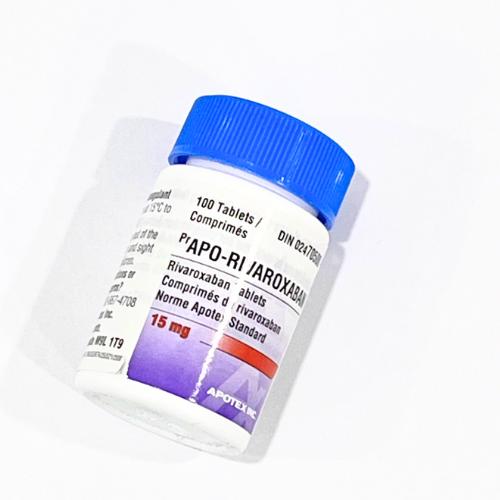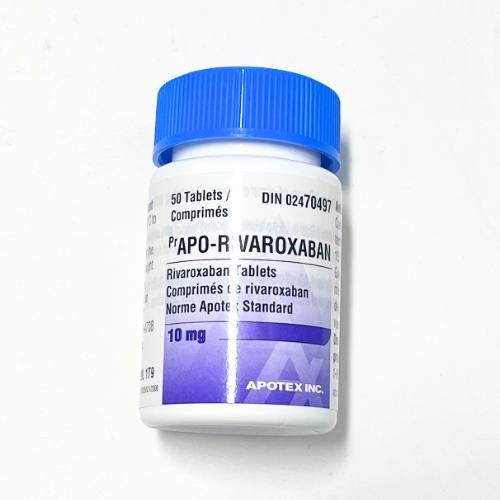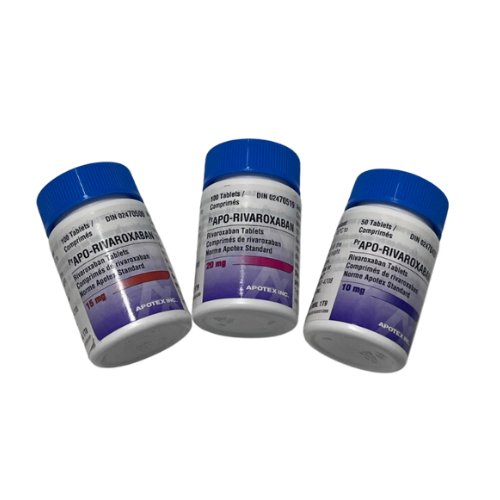Please note: a valid prescription is required for all prescription medication.
Rivaroxaban Tablets for Atrial Fibrillation
Buy More, Save More: Get 20% off when you buy 3 or more of any one product using code LESS20 at checkout.
Applies to all products originating from Canada. Maximum allowable quantity equal to a 90-day supply per single order.
Price range: $39.99 through $3,183.99
Secure Encrypted Payments
Rivaroxaban is an oral anticoagulant used to treat and prevent blood clots. This page explains key uses, dosing basics, and access so you can plan care with US delivery from Canada. You can also review Rivaroxaban price without insurance considerations to understand typical cash-pay expectations.
What Rivaroxaban Is and How It Works
This medicine belongs to a class called direct oral anticoagulants. It selectively blocks Factor Xa, a key step in the clotting cascade. By reducing thrombin generation, it helps lower the risk of clot formation in veins and arteries.
It is approved for stroke risk reduction in nonvalvular atrial fibrillation, treatment of deep vein thrombosis and pulmonary embolism, prevention of recurrent DVT/PE, and prevention of venous clots after hip or knee replacement. It is also used with aspirin to help reduce cardiovascular events in select patients with chronic coronary or peripheral artery disease.
Border Free Health connects U.S. patients with licensed Canadian partner pharmacies; prescriptions are verified with prescribers before dispensing.
Learn more about related conditions: Atrial Fibrillation and Cardiovascular.
Who It’s For
This treatment is used in adults who need anticoagulation for approved indications. It may be considered for nonvalvular atrial fibrillation to reduce stroke risk, for active DVT or PE, to prevent recurrence after initial therapy, and after certain orthopedic surgeries to prevent clots. In chronic CAD or PAD, a low-dose regimen with aspirin may be used for event risk reduction as per labeling.
People with active major bleeding, significant liver disease associated with coagulopathy, or prosthetic heart valves should not use this medicine. Those with severe renal impairment or taking certain interacting drugs may require different options per the official label. Pregnant or breastfeeding individuals should discuss risks with a clinician.
Dosage and Usage
Follow the directions on your prescription label. For atrial fibrillation, dosing is typically once daily with food. For DVT/PE treatment, dosing may start more frequently, then transition to once daily maintenance. After hip or knee replacement, preventive dosing is once daily for a limited period as directed. In CAD/PAD, a low-dose regimen may be combined with aspirin per the label.
Take tablets at the same time each day. Swallow with water. If taking a dose scheduled with food, pair it with a meal. If you have difficulty swallowing whole tablets, review the administration options in the official prescribing information.
Strengths and Forms
This therapy is supplied as film‑coated tablets. Commonly published strengths include 2.5 mg, 10 mg, 15 mg, and 20 mg. Availability may vary by manufacturer and market. When prescribed for specific conditions, your prescriber will match the strength to your clinical needs. Some packaging includes blister cards to help track doses.
For reference, some patients are prescribed Rivaroxaban 20 mg tablets for certain once‑daily regimens, based on indication and clinical profile.
Missed Dose and Timing
If you miss a once‑daily dose, take it as soon as you remember on the same day, then take the next dose at your usual time the following day. If you are on a twice‑daily schedule, the missed dose guidance differs by indication; consult the official label for details. Do not double up beyond label instructions. Try setting reminders to help maintain steady use.
Storage and Travel Basics
Store tablets at room temperature in the original package, away from moisture. Keep out of reach of children and pets. For travel, carry your medication in your hand luggage along with a copy of your prescription. Use a daily pill organizer only if it does not expose tablets to excess humidity. If your plan involves time-zone changes, keep the interval consistent rather than the clock time.
Benefits
This anticoagulant can reduce the risk of stroke in eligible patients with atrial fibrillation. It treats DVT and PE and helps prevent recurrence after the initial phase. Many regimens are once daily, which may support adherence. No routine lab monitoring is required for dosing decisions under usual circumstances, which can simplify ongoing care.
Side Effects and Safety
- Bleeding or bruising more easily
- Nosebleeds or bleeding gums
- Fatigue or dizziness
- Upset stomach
Serious bleeding can occur, including gastrointestinal or intracranial bleeding. Seek urgent care for signs such as coughing up blood, black stools, severe headache, or weakness. Rare events include allergic reactions or liver-related effects. Because this therapy affects clotting, any unplanned procedures, accidents, or new medicines should be discussed with a healthcare professional promptly.
Drug Interactions and Cautions
Certain medications can change exposure, including strong CYP3A and P‑gp inhibitors or inducers. Combining with other agents that increase bleeding risk, such as antiplatelets or NSAIDs, can raise bleeding potential. Alcohol may further increase bleeding risk. Kidney and liver function can influence suitability. Tell your prescriber about all medicines, vitamins, and herbal products you use.
What to Expect Over Time
Expect a steady routine once your schedule is established. Many patients take it long term for atrial fibrillation or extended prevention of clots, based on clinical judgment. For surgery‑related prophylaxis, use is short term. If your clinician changes any other therapies, they may reassess this anticoagulant for continued fit. Keep all appointments and review any signs of bleeding, new conditions, or planned procedures.
Compare With Alternatives
Other direct oral anticoagulants may be options if your prescriber recommends a change. Two common alternatives are Eliquis® (apixaban) and Pradaxa® (dabigatran). Each agent has specific dosing schedules, food considerations, and interaction profiles. Your clinician can help select the agent that matches your condition, kidney function, and co‑medications.
Pricing and Access
We offer Canadian pharmacy access with transparent options and US shipping from Canada. If you are comparing therapies by strength, people often search for Xarelto 20 mg price for reference. Generic options may lower out‑of‑pocket exposure; you can also compare Xarelto generic price for context across manufacturers. See current offers on our Promotions page. Checkout uses encrypted checkout for added security.
To estimate your total, add the item to cart, upload your prescription, and proceed to verification. Final costs can vary by strength, supply length, and manufacturer. Your prescriber’s directions determine the quantity we can dispense.
Availability and Substitutions
Supply can vary by manufacturer and strength. If a requested pack is unavailable, your prescriber may recommend a suitable alternative or different package size. You can review Canadian Xarelto price discussions in public sources if you wish to compare branded and generic options, then ask your clinician about clinical equivalence.
Country of origin details are noted where possible; see Canada for typical sourcing.
Patient Suitability and Cost-Saving Tips
Good candidates are adults who need anticoagulation for labeled uses and do not have major contraindications. Those at high bleeding risk or with specific organ issues may need alternate strategies. Consider multi‑month supplies if appropriate, which can reduce per‑fill overhead. Set refill reminders so you do not miss doses. If your insurance does not cover this therapy, ask whether a different strength or manufacturer could improve affordability without changing your prescribed regimen.
Questions to Ask Your Clinician
- My indication: what dose schedule fits my condition?
- Food and timing: should I take it with meals?
- Other medicines: which interactions should I avoid?
- Warning signs: when should I contact the office or seek care?
- Procedures: how should I manage this therapy around surgery or dental work?
- Duration: how long might I need anticoagulation for my case?
Authoritative Sources
Manufacturer Prescribing InformationFDA DailyMed: RivaroxabanHealth Canada Drug Product Database
Start your order at BorderFreeHealth for prompt, express shipping that Ships from Canada to US. This information is not a substitute for professional medical advice; always consult your healthcare professional. Prescription required.
Express Shipping - from $25.00
Shipping with this method takes 3-5 days
Prices:
- Dry-Packed Products $25.00
- Cold-Packed Products $35.00
Shipping Countries:
- United States (all contiguous states**)
- Worldwide (excludes some countries***)
Standard Shipping - $15.00
Shipping with this method takes 5-10 days
Prices:
- Dry-Packed Products $15.00
- Not available for Cold-Packed products
Shipping Countries:
- United States (all contiguous states**)
- Worldwide (excludes some countries***)
How does rivaroxaban differ from warfarin?
Rivaroxaban is a direct Factor Xa inhibitor with fixed dosing and no routine lab monitoring for dose adjustments under usual circumstances. Warfarin works by inhibiting vitamin K–dependent clotting factors and requires INR monitoring with dose changes. Dietary vitamin K and many drugs can affect warfarin response. Your clinician may choose one based on indication, kidney and liver function, interactions, and your ability to attend monitoring visits.
Can I take this anticoagulant with aspirin or NSAIDs?
Combining with aspirin or other antiplatelet agents can increase bleeding risk. In certain cases, a low-dose regimen with aspirin is used under label guidance for coronary or peripheral artery disease. NSAIDs may also raise bleeding risk. Discuss all over‑the‑counter and prescription medications with your prescriber before combining them with this therapy.
What if I need surgery or dental work while taking it?
Tell your prescriber and dentist as soon as a procedure is planned. They will decide if and when to pause and restart therapy, based on bleeding risk, kidney function, and the type of procedure. Do not stop on your own unless instructed. Emergency procedures should be managed in coordination with your care team, who may consult reversal and supportive measures per guidelines.
Does food affect how I should take my dose?
For certain indications, doses should be taken with food to support absorption. Other regimens may not require food. Follow the directions on your prescription label and the official prescribing information. If you are unsure about your specific schedule, contact your prescriber or pharmacist for clarification before making changes.
How long will I need to stay on therapy?
Duration depends on your condition and risk factors. Atrial fibrillation often requires ongoing anticoagulation. DVT or PE treatment may have an initial period followed by longer prevention, as appropriate. Post‑surgery prevention is short term. Your clinician will reassess during follow‑ups and adjust your plan as clinical factors change over time.
What are signs of serious bleeding to watch for?
Seek immediate care for coughing or vomiting blood, black or bloody stools, severe headache, weakness on one side, chest pain, or unexplained dizziness. Report nosebleeds that do not stop, unusual bruising, or pink or brown urine. Keep emergency contact numbers available and inform caregivers that you are using an anticoagulant.
Can tablets be split, crushed, or given via feeding tube?
Some administration options are described in the official label, including crushing tablets for certain routes. However, the details depend on the strength and indication. Do not alter tablets unless your prescriber confirms it is appropriate for your regimen. Review the product labeling or consult your pharmacist to understand the correct method for your situation.
Rewards Program
Earn points on birthdays, product orders, reviews, friend referrals, and more! Enjoy your medication at unparalleled discounts while reaping rewards for every step you take with us.
You can read more about rewards here.
POINT VALUE
How to earn points
- 1Create an account and start earning.
- 2Earn points every time you shop or perform certain actions.
- 3Redeem points for exclusive discounts.
How to book an appointment
- 1Create Begin by completing a profile or log into your existing account. This step ensures we have the necessary information to provide you with a service that's tailored to your needs. account and start earning.
- 2Scheduling an appointment with our online booking system is easy. Pick a day and time that suits you. You’ll receive an immediate confirmation, without the wait.
- 3Discuss your concerns and symptoms and receive a thorough diagnosis from one of our licensed doctors during a confidential video appointment.
- 4If you've been prescribed medication, your Rx is sent directly to one of our licensed pharmacies and delivered right to your door.
Get Started
To book an online doctor appointment, register for an account or login. After doing so, you can book your visit on this page.




